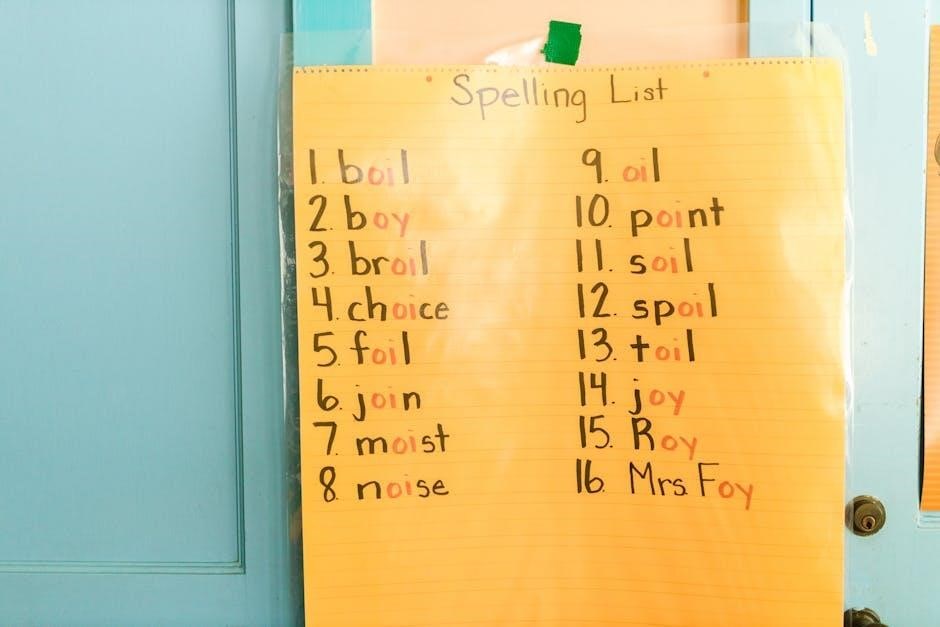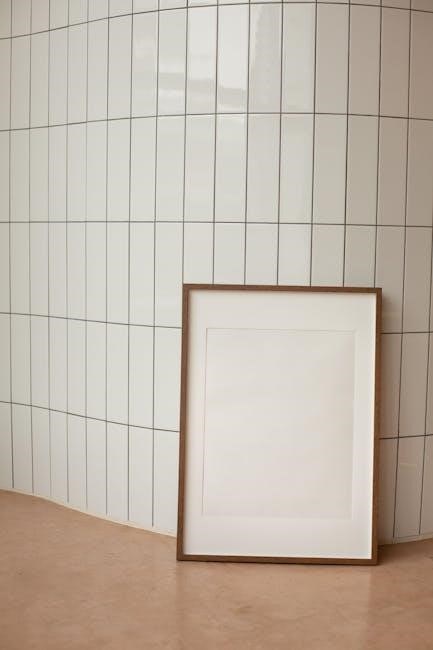Wall art size significantly impacts a room’s aesthetic‚ creating balance and harmony. Properly scaled pieces enhance ambiance‚ while incorrect sizes can overwhelm or feel insignificant. Choosing the right dimensions ensures art complements the space‚ reflecting personal style and elevating decor effectively.
1.1 The Role of Wall Art in Interior Design
Wall art serves as a powerful tool in interior design‚ setting the tone and personality of a space. It adds visual interest‚ creates focal points‚ and reflects personal style. Artwork can unify design elements‚ enhance ambiance‚ and inspire emotional connections‚ making it a cornerstone of cohesive and impactful room aesthetics.
1.2 Why Wall Art Size Matters for Aesthetics
Wall art size plays a crucial role in achieving aesthetic balance; Properly scaled pieces create harmony‚ while oversized or undersized art can disrupt the room’s visual equilibrium. The right size enhances the space’s ambiance‚ ensuring the art becomes a focal point without overwhelming the environment. It also ensures the piece complements surrounding furniture and decor seamlessly.
Understanding the 60-75% Rule for Wall Art Placement
The 60-75% rule guides wall art placement‚ ensuring pieces are proportionate to available space. This balance enhances aesthetics‚ preventing art from overwhelming or appearing too small‚ thus creating harmony.
2.1 Measuring Wall Space Effectively
Accurate wall measurements are crucial for selecting the right art size. Use a tape measure to assess the wall’s width and height. Consider the area above furniture or between fixtures. Measure both dimensions to ensure proper fit. For large walls‚ calculate the diagonal to understand spatial proportions. This step ensures your art fits seamlessly‚ enhancing the room’s aesthetic balance.
2.2 Applying the 60-75% Rule for Optimal Aesthetics
The 60-75% rule ensures wall art proportions align with the space. Measure the wall or furniture width‚ then select art that occupies 60-75% of that dimension. For example‚ a 120cm wall should feature art between 72cm and 90cm wide. This guideline creates visual harmony‚ preventing the art from appearing too small or overwhelming‚ while enhancing the room’s overall design;

Standard Wall Art Sizes by Region
Wall art sizes vary by region‚ with North America favoring varied dimensions‚ Europe adhering to the A series standard‚ and Australia blending both for diverse aesthetic preferences.
3.1 North America: Varied Dimensions
In North America‚ wall art sizes are diverse‚ reflecting a mix of creative freedom and functional design. Common print dimensions include 18×14‚ 21×16‚ 30×22‚ and 36×24 inches. These varied sizes cater to different room layouts‚ allowing homeowners to choose pieces that fit their unique spaces and decorative styles‚ ensuring a personalized aesthetic without strict adherence to a single standard.
3.2 Europe: The A Series Standard
In Europe‚ wall art sizes align with the A series standard‚ following ISO 216. Common sizes include A4 (21×29.7 cm) and A3 (29.7×42 cm). This systematic approach ensures each size is half the area of the previous‚ maintaining proportions. The A series offers a cohesive‚ balanced look‚ making it easier to select art that fits seamlessly into European interior design aesthetics and spatial requirements.
3.3 Australia: A Mix of Standards
Australia combines both A series and North American sizes‚ offering diverse options. Common sizes include A4 (21×29.7 cm) and 12×18 inches. This blend provides flexibility for art enthusiasts‚ allowing pieces to fit various spaces while maintaining global aesthetic compatibility. The mix caters to different interior styles‚ ensuring Australian homes can embrace a wide range of artistic and cultural influences seamlessly.

Aspect Ratio: Understanding Proportions
Aspect ratio refers to the width-to-height relationship of an image. Common ratios like 2:3‚ 3:4‚ and 1:1 influence how art displays‚ impacting the room’s aesthetic and spatial balance effectively.
4.1 What is Aspect Ratio?
Aspect ratio defines the proportional relationship between an image’s width and height. Expressed as two numbers separated by a colon‚ it determines the shape and orientation of wall art. Common ratios include 2:3‚ 3:4‚ and 1:1‚ each influencing the visual appeal and spatial harmony in a room. Properly chosen‚ it enhances the overall aesthetic and balance of the space effectively.
4.2 Common Aspect Ratios and Their Impact
Aspect ratios like 2:3‚ 3:4‚ and 1:1 are widely used in wall art‚ each offering unique visual effects. A 2:3 ratio suits vertical spaces‚ while 3:4 creates balanced‚ timeless compositions. Square 1:1 ratios bring symmetry‚ ideal for modern designs. These proportions ensure art aligns with room aesthetics‚ enhancing spatial harmony and visual appeal without distortion or imbalance‚ making them essential for cohesive interior design.
Sizing Wall Art for Different Furniture
Wall art size should complement furniture dimensions‚ with pieces above sofas or beds measuring 60-75% of the furniture’s width for balanced proportions and visual harmony.
5.1 Wall Art Above Sofas and Beds
When placing wall art above sofas or beds‚ ensure it measures 60-75% of the furniture’s width for balanced proportions. Standard sizes like 30×40″ or 36×48″ work well‚ depending on the room’s scale. Aspect ratios should complement the space‚ avoiding distortion. This rule ensures the art enhances the focal point without overwhelming the area‚ creating a harmonious and visually appealing setup.
5.2 Wall Art in Relation to Other Furniture
When selecting wall art near other furniture‚ consider the size and proportions of nearby pieces. For example‚ above a chair or table‚ art should be 1/2 to 2/3 the width of the furniture. Measure the wall space and ensure the art complements the room’s decor without overwhelming it. Balanced placement enhances visual harmony and creates a cohesive look.

Wall Art Size Guide for Different Room Sizes
Room size dictates wall art proportions‚ ensuring harmony and balance. Small rooms need compact art‚ while larger spaces can accommodate oversized pieces‚ enhancing ambiance and visual appeal.
6.1 Small Spaces: Bathrooms‚ Bedrooms‚ Offices
For small spaces like bathrooms‚ bedrooms‚ and offices‚ opt for compact wall art sizes such as 11×14 inches or 6×8 inches. These proportions ensure a balanced look without overwhelming the area. In tight spaces‚ smaller prints can be propped on shelves or desks‚ creating a subtle yet elegant display that enhances the room’s intimacy and functionality without cluttering it.
6.2 Medium Spaces: Living Rooms‚ Dining Rooms
In medium spaces like living rooms and dining rooms‚ art prints sized around 18×24 inches or 20×20 inches work well. These dimensions create a focal point without overwhelming the room. Square prints‚ such as 20×20 inches‚ add balance‚ while slightly larger pieces like 28×28 inches can make a bold statement in more spacious areas‚ enhancing the room’s aesthetic and functionality effectively.
6.3 Large Spaces: Open-Plan Areas‚ High Ceilings
For large spaces with open-plan areas and high ceilings‚ oversized wall art creates a dramatic impact. Consider prints sized 40×54 inches or larger‚ occupying 60-75% of the wall space. Vertical pieces‚ like 36×48 inches‚ are ideal for high ceilings‚ drawing the eye upward and enhancing the sense of grandeur while maintaining visual harmony in expansive rooms.
Creating Gallery Walls: Mixing Sizes and Styles
Mixing wall art sizes and styles creates dynamic‚ visually engaging displays. Combine small and large prints‚ varied frames‚ and contrasting themes to craft a cohesive‚ harmonious gallery wall.

7.1 Tips for Mixing Different Print Sizes
Mixing print sizes adds depth to gallery walls. Start with a unifying element‚ like frame style or color palette. Balance large and small prints to avoid visual clutter. Use a focal point‚ such as an oversized piece‚ to anchor the display. Ensure smaller prints are grouped thoughtfully to maintain harmony and create a cohesive‚ visually engaging arrangement.

7.2 Achieving Cohesion in Gallery Wall Displays
Cohesion in gallery walls requires a unified theme‚ such as color‚ style‚ or subject matter. Frames should complement each other‚ while spacing between pieces ensures a clean look. A central focal point guides the eye‚ creating flow. Mixing sizes and styles thoughtfully results in a dynamic yet harmonious display that reflects personal taste and enhances the room’s aesthetic.

Custom Wall Art Options
Custom wall art offers homeowners the ability to personalize sizes and styles‚ ensuring pieces fit their space perfectly. Popular sizes include 18×14 and 21×16 inches‚ allowing for unique‚ tailored displays that enhance any room’s ambiance.
8.1 Benefits of Custom Sizes
Custom wall art sizes provide a tailored fit for unique spaces‚ ensuring the piece complements the room’s dimensions and style. This flexibility allows homeowners to create a personalized aesthetic‚ enhancing the space’s ambiance without compromising on design. Custom options also offer a budget-friendly alternative to traditional custom artwork‚ making distinctive decor more accessible.
8.2 Considerations for Custom Art Prints
When opting for custom art prints‚ consider factors like wall space‚ furniture size‚ and room aesthetics. While custom sizes offer flexibility‚ they may be pricier than standard options. Additionally‚ ensure the aspect ratio aligns with the space to maintain visual harmony and avoid distortion. Proper planning ensures a seamless integration of the artwork into the room’s design.

Balancing Visual Weight and Scale
Size and placement are crucial for balance‚ ensuring larger art commands attention without overwhelming the space. Careful curation of scale creates harmony‚ enhancing the room’s aesthetic flow naturally.
9.1 Techniques for Visual Harmony
Techniques like proportional balancing and focal point creation ensure visual harmony. Mixing sizes and styles thoughtfully prevents overwhelming the space‚ while symmetry and alignment enhance cohesion. Proper spacing and frame selection further refine the aesthetic‚ ensuring each piece complements the room’s design without competition‚ creating a balanced and visually pleasing environment for all to enjoy.
9.2 Avoiding Overpowering the Space
To prevent overwhelming a room‚ measure walls and furniture to ensure art proportions align with the space. Choose frames and colors that complement the room’s style‚ avoiding bold patterns or overly large pieces that dominate. Proper spacing and balanced sizing maintain harmony‚ ensuring the art enhances rather than overwhelms the environment‚ creating a serene and inviting atmosphere.
Wall art size plays a crucial role in interior design‚ enhancing spaces when chosen thoughtfully. Experiment with proportions and styles to find the perfect balance‚ reflecting your unique taste and creating a harmonious environment that inspires and delights.
10.1 Recap of Key Considerations
When selecting wall art‚ consider room size‚ furniture proportions‚ and personal style. Measure walls and apply the 60-75% rule for optimal aesthetics. Choose frames and aspect ratios that complement surroundings. Balance visual weight and scale to avoid overwhelming the space. Experiment with gallery walls and custom sizes for a unique‚ cohesive look that enhances your home’s ambiance and reflects your taste.
10.2 Encouragement to Experiment and Find the Perfect Fit
Embrace creativity and experiment with wall art sizes to discover what resonates with you. Remember‚ there’s no one-size-fits-all solution—every space is unique. Use the 60-75% rule as a starting point‚ but feel free to adjust based on personal style. Balancing proportions and scales can transform a room‚ making it a true reflection of your identity and taste.
